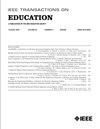Elevating Learning Effectiveness in Solid-State Physics Through Interactive Software and Stereoscopic Projection
IF 2
2区 工程技术
Q2 EDUCATION, SCIENTIFIC DISCIPLINES
引用次数: 0
Abstract
Contribution: An innovative approach utilizing interactive software paired with stereoscopic projection hardware is introduced to enhance the teaching and learning of solid-state physics. This method is distinctive for its integration of complex 3-D visualizations directly into classroom instruction, facilitating a deeper understanding of abstract concepts through interactive engagement.Background: This study is motivated by the challenges faced in teaching abstract concepts in a solid-state physics course, such as the energy band theory and Bravais lattices, to undergraduate students. Traditional teaching methods, such as blackboard teaching, or PowerPoint presentations often fail to adequately address these complexities, leading to a significant learning gap. This gap underlines the necessity for innovative educational tools that can bridge theoretical knowledge with practical understanding, applicable globally across educational programs.Intended Outcomes: The primary outcomes targeted by this approach include improved student engagement and learning efficacy, enhanced comprehension and retention of complex physics concepts, and better transfer of theoretical knowledge to practical applications.Application and Evaluation Experiment Design: The teaching tool integrates MATLAB-based interactive software with hardware utilizing the “Pepper Ghost” technique for 3-D stereoscopic visualization. This approach aims to foster an interactive and engaging learning environment, allowing complex physics concepts to be visualized intuitively. Assessment of learning effectiveness is carried out through the design of targeted questions, participant recruitment, and statistical analysis of questionnaire responses.Findings: Noticeable improvements in performance on both retention questions and transfer questions are observed, indicating that students exposed to this new teaching approach benefit in knowledge retention and application compared to those who experienced traditional teaching methods. These findings highlight the effectiveness of the integrated teaching tool in enhancing teaching outcomes in physics, suggesting its potential broad applicability in other fields.通过互动软件和立体投影提高固态物理的学习效果
贡献:介绍了一种利用交互式软件与立体投影硬件相结合的创新方法,以增强固态物理的教与学。这种方法的独特之处在于它将复杂的三维可视化直接融入课堂教学,通过互动参与促进对抽象概念的更深层次理解。背景:本研究的动机是在固态物理课程的抽象概念,如能带理论和Bravais晶格的教学面临的挑战,本科生。传统的教学方法,如黑板教学或ppt演示往往不能充分解决这些复杂性,导致显著的学习差距。这种差距强调了创新教育工具的必要性,这些工具可以将理论知识与实际理解联系起来,适用于全球各个教育项目。预期结果:该方法的主要目标包括提高学生的参与度和学习效率,增强对复杂物理概念的理解和记忆,以及更好地将理论知识转化为实际应用。应用与评价实验设计:该教学工具将基于matlab的交互软件与硬件相结合,利用“胡椒鬼”技术实现三维立体可视化。这种方法旨在培养一个互动和引人入胜的学习环境,使复杂的物理概念直观地可视化。学习效果的评估是通过针对性问题的设计、参与者的招募和问卷调查结果的统计分析来进行的。研究发现:在记忆问题和迁移问题上,学生的表现都有明显的提高,这表明与传统教学方法的学生相比,接触这种新教学方法的学生在知识的记忆和应用方面受益。这些发现突出了综合教学工具在提高物理教学成果方面的有效性,表明其在其他领域的潜在广泛适用性。
本文章由计算机程序翻译,如有差异,请以英文原文为准。
求助全文
约1分钟内获得全文
求助全文
来源期刊

IEEE Transactions on Education
工程技术-工程:电子与电气
CiteScore
5.80
自引率
7.70%
发文量
90
审稿时长
1 months
期刊介绍:
The IEEE Transactions on Education (ToE) publishes significant and original scholarly contributions to education in electrical and electronics engineering, computer engineering, computer science, and other fields within the scope of interest of IEEE. Contributions must address discovery, integration, and/or application of knowledge in education in these fields. Articles must support contributions and assertions with compelling evidence and provide explicit, transparent descriptions of the processes through which the evidence is collected, analyzed, and interpreted. While characteristics of compelling evidence cannot be described to address every conceivable situation, generally assessment of the work being reported must go beyond student self-report and attitudinal data.
 求助内容:
求助内容: 应助结果提醒方式:
应助结果提醒方式:


